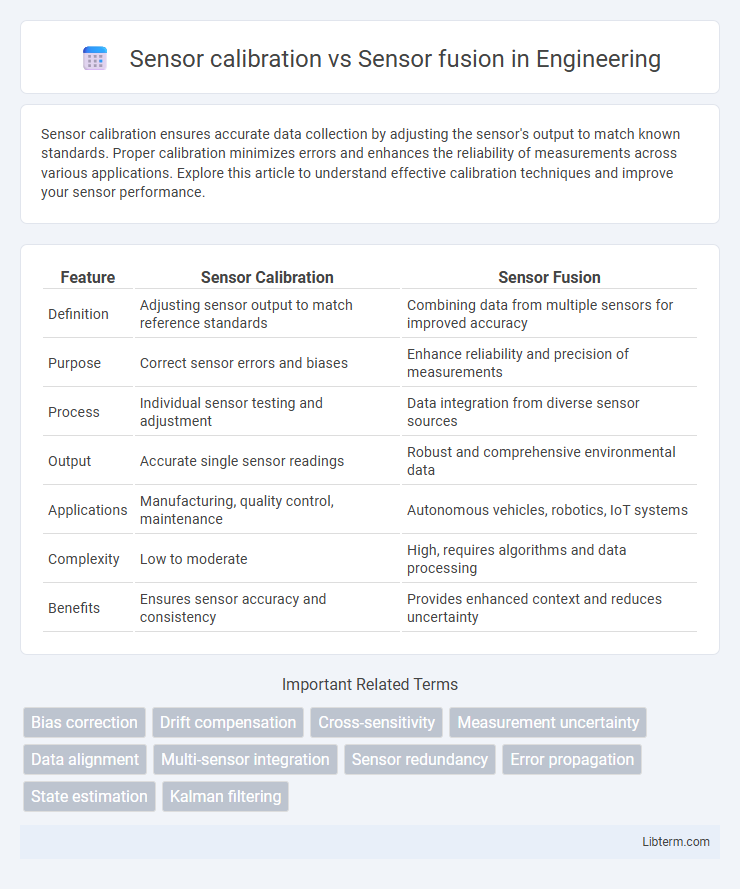Sensor calibration ensures accurate data collection by adjusting the sensor's output to match known standards. Proper calibration minimizes errors and enhances the reliability of measurements across various applications. Explore this article to understand effective calibration techniques and improve your sensor performance.
Table of Comparison
| Feature | Sensor Calibration | Sensor Fusion |
|---|---|---|
| Definition | Adjusting sensor output to match reference standards | Combining data from multiple sensors for improved accuracy |
| Purpose | Correct sensor errors and biases | Enhance reliability and precision of measurements |
| Process | Individual sensor testing and adjustment | Data integration from diverse sensor sources |
| Output | Accurate single sensor readings | Robust and comprehensive environmental data |
| Applications | Manufacturing, quality control, maintenance | Autonomous vehicles, robotics, IoT systems |
| Complexity | Low to moderate | High, requires algorithms and data processing |
| Benefits | Ensures sensor accuracy and consistency | Provides enhanced context and reduces uncertainty |
Introduction to Sensor Calibration and Sensor Fusion
Sensor calibration involves adjusting and fine-tuning sensors to ensure accurate and reliable data by compensating for errors and environmental factors. Sensor fusion combines data from multiple calibrated sensors to enhance accuracy, robustness, and provide comprehensive situational awareness. Both processes are essential for optimizing sensor performance in applications such as autonomous vehicles, robotics, and IoT systems.
Defining Sensor Calibration: Purpose and Methods
Sensor calibration involves adjusting and fine-tuning sensor outputs to align with standardized reference values, ensuring accuracy and reliability in measured data. Common calibration methods include using known reference materials, environmental conditions, or controlled input signals to identify and correct systematic errors. This process is essential for maintaining sensor precision before integrating multiple data sources in sensor fusion applications.
Understanding Sensor Fusion: Principles and Techniques
Sensor fusion integrates data from multiple sensors to improve accuracy and reliability in systems like autonomous vehicles and robotics. Techniques such as Kalman filtering, Bayesian networks, and deep learning algorithms combine sensor outputs to mitigate individual sensor noise and errors. Understanding sensor fusion principles enables enhanced decision-making by producing a comprehensive, consistent representation of the environment.
Key Differences Between Calibration and Fusion
Sensor calibration involves adjusting and fine-tuning individual sensors to ensure accurate measurements by correcting systematic errors and biases. Sensor fusion combines data from multiple calibrated sensors to create a more comprehensive, accurate, and reliable understanding of the environment, often using algorithms like Kalman filters or machine learning models. Calibration is a prerequisite for effective fusion, as inaccurate sensor data can degrade fusion outcomes, while fusion enhances overall system performance by leveraging complementary sensor strengths.
Importance of Sensor Calibration in Data Accuracy
Sensor calibration is crucial for ensuring data accuracy by correcting systematic errors and aligning sensor readings with real-world measurements. Proper calibration enhances the reliability of sensor fusion processes, where data from multiple sensors are combined to provide comprehensive insights. Without accurate calibration, the integrated data from sensor fusion can be misleading, compromising decision-making and system performance.
Enhancing System Performance with Sensor Fusion
Sensor fusion integrates data from multiple calibrated sensors to enhance system accuracy, reliability, and robustness beyond individual sensor capabilities. Proper sensor calibration ensures each sensor provides precise measurements, which is critical for effective data fusion and minimizing systemic errors. Combining sensor calibration with advanced sensor fusion algorithms significantly improves overall system performance in applications such as autonomous vehicles, robotics, and IoT devices.
Common Applications of Sensor Calibration
Sensor calibration ensures accurate and reliable data by adjusting sensor outputs to match known standards, essential in aerospace navigation systems, automotive safety features like collision avoidance, and medical devices for precise patient monitoring. It is critical for maintaining sensor performance in industrial automation, where accurate measurements impact process control and quality assurance. Properly calibrated sensors enhance the effectiveness of sensor fusion techniques, which combine data from multiple calibrated sensors to improve decision-making in robotics and smart city infrastructure.
Real-World Use Cases for Sensor Fusion
Sensor calibration ensures the accuracy and reliability of individual sensor measurements by eliminating systematic errors, which is crucial for precise data collection. Sensor fusion combines data from multiple calibrated sensors to create a comprehensive and robust understanding of the environment, enhancing decision-making in complex systems. Real-world use cases for sensor fusion include autonomous vehicles that integrate LIDAR, radar, and cameras to improve obstacle detection and navigation, and industrial robotics where fused sensor data optimizes precision and adaptability in dynamic manufacturing settings.
Challenges in Implementing Sensor Calibration vs Fusion
Sensor calibration faces challenges such as environmental variability, sensor drift, and the need for frequent re-calibration to maintain accuracy in data collection. Sensor fusion struggles with integrating heterogeneous data sources, managing differing data rates, and resolving conflicting sensor outputs to provide a coherent and reliable interpretation. Both processes require sophisticated algorithms and computational resources to overcome noise, latency, and system complexity in real-time applications.
Future Trends in Sensor Calibration and Sensor Fusion
Future trends in sensor calibration emphasize the integration of AI-driven algorithms to enhance accuracy and automate real-time adjustments, reducing manual intervention and sensor drift over time. Advances in sensor fusion focus on combining data from diverse sensor arrays such as LiDAR, radar, and inertial measurement units (IMUs) to improve situational awareness and decision-making in autonomous systems. Emerging technologies are driving the development of adaptive, self-calibrating sensor networks that optimize performance in dynamic environments and support next-generation applications like smart cities and advanced robotics.
Sensor calibration Infographic

 libterm.com
libterm.com